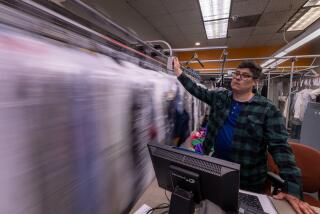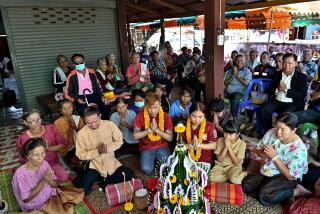Photo Essay : Clinging to ‘City of Darkness’
HONG KONG — “I live here. I work here. It is my home. But now I must go and leave my world behind,” said Cheung Muk-ching, a 66-year-old shop owner residing deep within the labyrinthine Walled City just north of Hong Kong’s international airport.
Cheung’s neighborhood is a monument to man’s ability to survive in adverse surroundings. The Walled City--still called that even though Japanese occupiers pulled down the boundary walls during World War II--is one of the more densely populated tenement districts on Earth. The Chinese call it Hak Nam , the “City of Darkness,” and Cheung, who has lived here for more than 40 years, is an expert guide.
Here, in a filthy, dingy room, he talks to two chefs clad only in shorts and sandals while they prepare an order of bite-size custard pies for a local bakery. There, in the front window of an unlicensed dentist’s shop, he laughingly points to a display of ready-to-wear dentures. Turn a corner and an oversized rat darts through the maze of dark, damp passageways. Cheung throws an empty bottle at it before it squeezes through a hole and plunges into the open sewers below. The stench of human waste and rotting garbage is overwhelming.
The alleys of the Walled City are so narrow that no vehicles can enter them. Many of the buildings lean into each other or they would tumble over. Small shops and factories with ancient machinery, making everything from plastic ornaments to noodles, line the narrow streets, as do dark stairways that lead up to the apartments. Sunlight reaches only a few areas.
For all its squalor, Cheung would like to stay in the Walled City. But in less than a year, that will no longer be possible. The Hong Kong government is expected to complete the fourth and final phase of a systematic clearance scheme next June. After all the residents are gone, the neighborhood is to be leveled and the seven-acre site--about the size of a modest U.S. shopping mall--converted into a public park.
Seventy percent of the Walled City’s 30,000 inhabitants have already moved out and been compensated. Of the 10,000 who remain, 120--including Cheung--have refused to move, and as the June, 1992, deadline approaches, there may be more who will try to defy the government plan.
“The government’s compensation is not enough to start a new life outside of the Walled City,” Cheung said. “Besides, I’m too old to start another business. I refuse to be forced out of my home.”
The decision to implement the massive urban renewal project came by way of secret talks between the Chinese and the British governments more than three years ago. It is part of preparations to return the British colony to Chinese sovereignty in 1997.
Philip Chok, Hong Kong’s deputy secretary for home affairs and overseer of the city’s clearance plan, said the Walled City will soon be relegated to the place it deserves--in the history books.
“It is very much to the benefit of Hong Kong that we do something about the Walled City, which really is a slum,” Chok said. Conditions there, he added, “are very much an environmental and safety hazard.” He characterized as very favorable the government’s proffered compensation package to residents, which is valued at $300 million.
Choi Wing-kwai is a reformed drug dealer familiar with the Walled City’s underside. “I left southern China for Hong Kong in 1954 to enter the business of selling opium and heroin in the Walled City. The opium dens have gone, but the heroin addicts remain. Although I don’t sell drugs anymore, I know addicts seek protection within the city,” Choi said.
Added a younger drug dealer who grew up in the Walled City: “Most of the addicts think they will be able to receive rehousing compensation from the government but continue to live here. They don’t understand what is about to happen to them.”
In addition to holdouts among some longtime residents, officials are running into resistance from more than 120 unlicensed doctors and dentists who hang their shingles in the Walled City.
The government said it will not allow unlicensed medics to practice outside the Walled City because they would lower medical standards in the territory. So accepting the government’s buyout offer would mean going out of business for people like Chan Po-cheng, an unlicensed dentist from Guangdong province in southeastern China. “I am too old to take the licensing exam,” complained Chan, 50. “It is a shame for me lose my practice after serving the community for more than 20 years.”
But Chok said the government’s terms are non-negotiable.
And for many, like Suen Mai-lan, 38, the demise of Hak Nam is a chance to bury a painful past. Suen has just accepted the government’s terms and is renting a public housing apartment outside the Walled City. “I am much happier now because my husband will have the chance to break his drug habit and start a new life,” she said.
Suen returns to the Walled City every day to work at her mother-in-law’s bakery and to meet with old friends, many of whom have also moved. “Growing up in the Walled City exposed me to a lot of bad things,” she said. “But now I live where the sun shines and the air is fresh.”
More to Read
Sign up for The Wild
We’ll help you find the best places to hike, bike and run, as well as the perfect silent spots for meditation and yoga.
You may occasionally receive promotional content from the Los Angeles Times.






